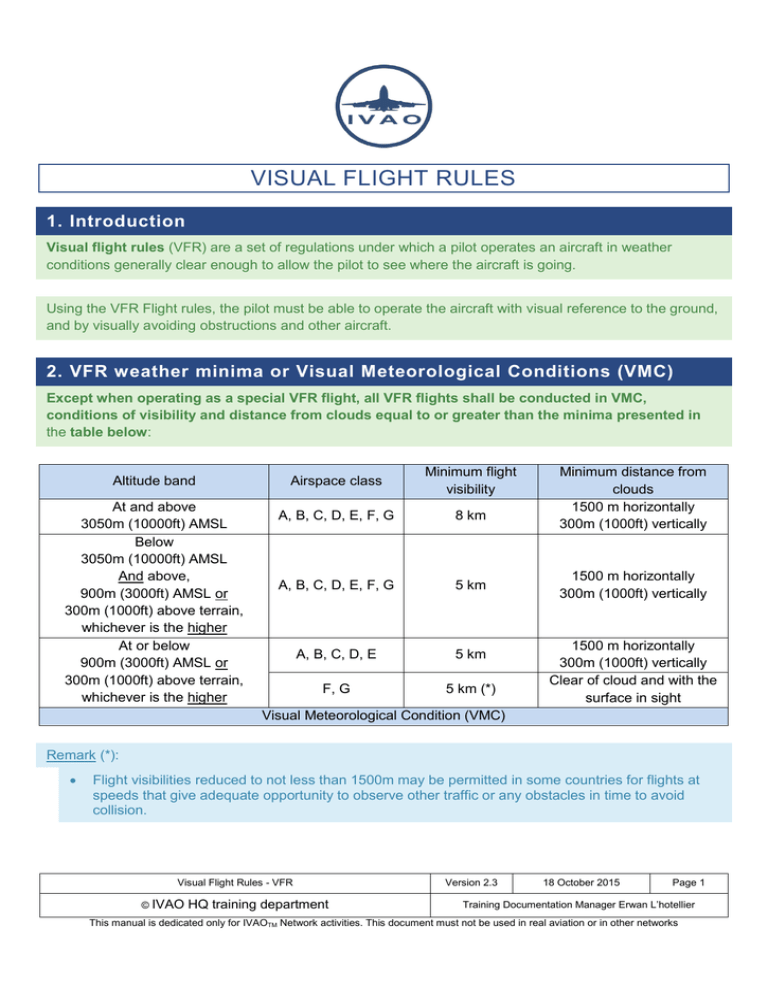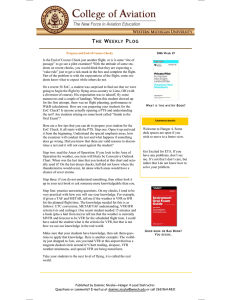Visual Flight Rules (VFR) Training Guide
advertisement

VISUAL FLIGHT RULES 1. Introduction Visual flight rules (VFR) are a set of regulations under which a pilot operates an aircraft in weather conditions generally clear enough to allow the pilot to see where the aircraft is going. Using the VFR Flight rules, the pilot must be able to operate the aircraft with visual reference to the ground, and by visually avoiding obstructions and other aircraft. 2. VFR weather minima or Visual Meteorological Conditions (VMC) Except when operating as a special VFR flight, all VFR flights shall be conducted in VMC, conditions of visibility and distance from clouds equal to or greater than the minima presented in the table below: Altitude band At and above 3050m (10000ft) AMSL Below 3050m (10000ft) AMSL And above, 900m (3000ft) AMSL or 300m (1000ft) above terrain, whichever is the higher At or below 900m (3000ft) AMSL or 300m (1000ft) above terrain, whichever is the higher Airspace class Minimum flight visibility A, B, C, D, E, F, G 8 km A, B, C, D, E, F, G 5 km A, B, C, D, E 5 km F, G 5 km (*) Minimum distance from clouds 1500 m horizontally 300m (1000ft) vertically 1500 m horizontally 300m (1000ft) vertically 1500 m horizontally 300m (1000ft) vertically Clear of cloud and with the surface in sight Visual Meteorological Condition (VMC) Remark (*): Flight visibilities reduced to not less than 1500m may be permitted in some countries for flights at speeds that give adequate opportunity to observe other traffic or any obstacles in time to avoid collision. Visual Flight Rules - VFR © IVAO HQ training department Version 2.3 18 October 2015 Page 1 Training Documentation Manager Erwan L’hotellier This manual is dedicated only for IVAOTM Network activities. This document must not be used in real aviation or in other networks Other Remarks: When the height of the transition altitude is lower than 3050m (10000ft) AMSL, FL100 should be used. Helicopters may be permitted to operate in less than 1500m flight visibility if they can observe other traffic and any obstacles in time to avoid collision. (Depends on your country regulations). The VMC minima in class A airspace are included for guidance to pilots and do not imply acceptance of VFR flights in class A airspace automatically. 3. VFR Level restrictions 3.1. Minimal altitude All VFR flights shall not be flown except for take-off, landing or except by emission from the appropriate authority: At a height less than 150 m (500 ft) above the ground or water. At a height less than 300 m (1 000 ft) above the highest obstacle within a radius of 600 m from the aircraft over the congested areas of cities, towns or settlements or over an open-air assembly of persons. Some countries adopt a minimum height above 1000ft over natural parks and reserves. Some countries also make a minimum height of flight between 1000ft to 5000ft over cities. 3.2. Maximal altitude or flight level VFR civil flights shall not fly above FL200. All VFR flights are forbidden in RVSM airspace above FL290. The maximum VFR flight level is ICAO defined. According to your national regulation (AIP), it may be different. For military aircraft, please consult Special Operations Department for HQ rules or your Special Operations rules of your division to have the exact limitations. 3.3. Cruising flight level Except where otherwise indicated in air traffic control clearances or specified by the appropriate ATS authority, VFR flights when operated above 900 m (3 000ft) from the ground or water shall be conducted at a flight level/altitudes appropriate to the track as specified in the following levels : VFR flights use flight levels ending with the number 5: FL 45, FL 55, … VFR flights use altitudes ending with the number 500: 4500ft, 5500ft, … The cruise altitude (flight level) for VFR flights must be chosen using this assigned rules and must follow the semicircular rules depending on the heading of the aircraft. Check VFR cruise altitude documentation in order to have the full table with explanations including semicircular rules. Visual Flight Rules - VFR © IVAO HQ training department Version 2.3 18 October 2015 Page 2 Training Documentation Manager Erwan L’hotellier This manual is dedicated only for IVAOTM Network activities. This document must not be used in real aviation or in other networks 4. Air traffic Controlled Areas An air traffic control clearance shall be obtained prior to operating a controlled flight or a portion of a flight as a controlled flight: When operating a class B, C and D airspace When forming part of aerodrome traffic at a controlled aerodrome When operated special VFR In those cases, an aircraft operated as a controlled flight shall maintain continuous voice communication and establish two-way communication with the appropriate air traffic control unit. Note that in IVAO, the pilot must use text mode if the voice communication is not possible. 5. Change Flight Rules to IFR An aircraft operated in accordance with the visual flight rules which wishes to change to compliance with the Instrument Flight Rules shall: communicate the necessary changes to be effected to its current flight plan submit a flight plan to the air traffic services unit and obtain a clearance prior to proceeding IFR when in controlled airspace 6. Special VFR (SFVR) In a controlled aerodrome, the air traffic controller can issue a special VFR clearance to an aircraft, which is below the VMC minima in his controlled zone, in order to let him reach a new zone where the weather conditions follow the VMC rules. Special VFR clearance use depends on your local regulation (ATS authority): This type of clearance can be forbidden in some countries or on some airfields. Flight visibilities reduced to not less than 1500m (clear of clouds) is permitted for special VFR flights at speeds that give adequate opportunity to observe other traffic or any obstacles in time to avoid collision. 7. Night VFR (NVFR) The night VFR flight – called NVFR sometimes – is a VFR flight which is partly performed during the aeronautic night. In some countries or airfields, night VFR flights are not allowed. Please consult your national and local regulations. Visual Flight Rules - VFR © IVAO HQ training department Version 2.3 18 October 2015 Page 3 Training Documentation Manager Erwan L’hotellier This manual is dedicated only for IVAOTM Network activities. This document must not be used in real aviation or in other networks
